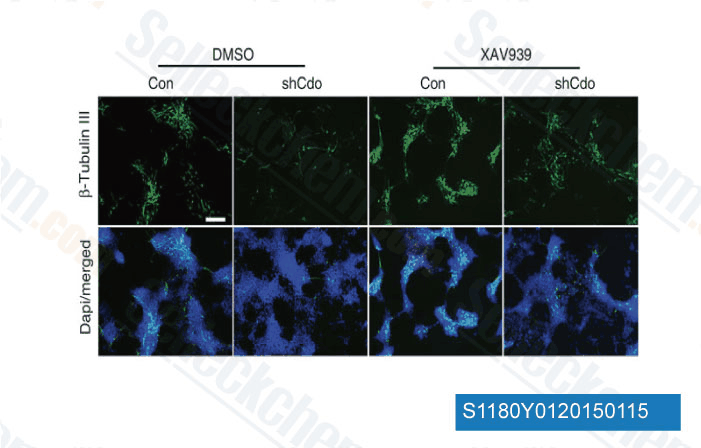|
Toll Free: (877) 796-6397 -- USA and Canada only -- |
Fax: +1-832-582-8590 Orders: +1-832-582-8158 |
Tech Support: +1-832-582-8158 Ext:3 Please provide your Order Number in the email. |
Technical Data
| Formula | C14H11F3N2OS |
|||
| Molecular Weight | 312.31 | CAS No. | 284028-89-3 | |
| Solubility (25°C)* | In vitro | DMSO | 12 mg/mL (38.42 mM) | |
| Water | Insoluble | |||
| Ethanol | Insoluble | |||
|
* <1 mg/ml means slightly soluble or insoluble. * Please note that Selleck tests the solubility of all compounds in-house, and the actual solubility may differ slightly from published values. This is normal and is due to slight batch-to-batch variations. * Room temperature shipping (Stability testing shows this product can be shipped without any cooling measures.) |
||||
Preparing Stock Solutions
Biological Activity
| Description | XAV-939 (NVP-XAV939) selectively inhibits Wnt/β-catenin-mediated transcription through tankyrase1/2 inhibition with IC50 of 11 nM/4 nM in cell-free assays, regulates axin levels and does not affect CRE, NF-κB or TGF-β. | ||||
|---|---|---|---|---|---|
| Targets |
|
||||
| In vitro | XAV-939 specifically inhibits tankyrase PARP activity. XAV-939 dramatically decreases DNA-PKcs protein levels, confirming the critical role of tankyrase poly-ADP-ribosylation activity in maintaining stability of the DNA-PKcs protein. The greatest reduction of DNA-PKcs protein levels (< 25% relative expression compared to DMSO treated controls) occurs at 12 hours with 1.0 μM XAV-939 exposure. Treatment of human lymphoblasts with 1.0 μM XAV-939 results in marked elevation of tankyrase 1 levels. [1] XAV-939 is axin stabilizing agent. XAV-939 stimulates beta-catenin degradation by stabilizing axin, the concentration-limiting component of the destruction complex. XAV-939 stabilizes axin by blocking the poly-ADP-ribosylating enzymes tankyrase 1 and tankyrase 2. Both tankyrase isoforms interact with a highly conserved domain of axin and stimulate its degradation through the ubiquitin-proteasome pathway. XAV-939 deregulates the Wnt/b-catenin pathway which has been implicated in many cancers. [2] |
||||
| In vivo | AV-939 (NVP-XAV939) selectively inhibits Wnt/β-catenin-mediated transcription through tankyrase1/2 inhibition. |
Protocol (from reference)
| Cell Assay: |
|
|---|---|
| Animal Study: |
|
References
|
Customer Product Validation

-
Data from [Data independently produced by Nat Commun, 2014, 5, 5455]

-
Data from [Data independently produced by Dis Model Mech, 2014, 7(10), 1193-203]

-
, , Cancer Lett, 2017, 400:194-202

-
,
Selleck's XAV-939 has been cited by 421 publications
| Spatial covariance reveals isothiocyanate natural products adjust redox stress to restore function in alpha-1-antitrypsin deficiency [ Cell Rep Med, 2025, 6(1):101917] | PubMed: 39809267 |
| Wnt signaling inhibits casein kinase 1α activity by modulating its interaction with protein phosphatase 2A [ Cell Rep, 2025, 44(2):115274] | PubMed: 39908140 |
| Dedifferentiated fat cells-derived exosomes (DFATs-Exos) loaded in GelMA accelerated diabetic wound healing through Wnt/β-catenin pathway [ Stem Cell Res Ther, 2025, 16(1):103] | PubMed: 40022232 |
| Regulation of ER stress-induced apoptotic and inflammatory responses via YAP/TAZ-mediated control of the TRAIL-R2/DR5 signaling pathway [ Cell Death Discov, 2025, 11(1):42] | PubMed: 39904986 |
| Tenascin-C Potentiates Wnt Signaling in Thyroid Cancer [ Endocrinology, 2025, 166(3)bqaf030] | PubMed: 39951495 |
| Chronic replication stress-mediated genomic instability disrupts placenta development in mice [ bioRxiv, 2025, 2025.02.28.640689] | PubMed: 40093167 |
| An iPSC model of fragile X syndrome reflects clinical phenotypes and reveals m 6 A- mediated epi-transcriptomic dysregulation underlying synaptic dysfunction [ bioRxiv, 2025, 2024.10.14.618205] | PubMed: 39464060 |
| Double-Network DNA Macroporous Hydrogel Enables Aptamer-Directed Cell Recruitment to Accelerate Bone Healing [ Adv Sci (Weinh), 2024, 11(1):e2303637] | PubMed: 37949678 |
| Activation of the Wnt/β-catenin signalling pathway enhances exosome production by hucMSCs and improves their capability to promote diabetic wound healing [ J Nanobiotechnology, 2024, 22(1):373] | PubMed: 38926800 |
| RNF166 promotes colorectal cancer progression by recognizing and destabilizing poly-ADP-ribosylated angiomotins [ Cell Death Dis, 2024, 15(3):211] | PubMed: 38480683 |
RETURN POLICY
Selleck Chemical’s Unconditional Return Policy ensures a smooth online shopping experience for our customers. If you are in any way unsatisfied with your purchase, you may return any item(s) within 7 days of receiving it. In the event of product quality issues, either protocol related or product related problems, you may return any item(s) within 365 days from the original purchase date. Please follow the instructions below when returning products.
SHIPPING AND STORAGE
Selleck products are transported at room temperature. If you receive the product at room temperature, please rest assured, the Selleck Quality Inspection Department has conducted experiments to verify that the normal temperature placement of one month will not affect the biological activity of powder products. After collecting, please store the product according to the requirements described in the datasheet. Most Selleck products are stable under the recommended conditions.
NOT FOR HUMAN, VETERINARY DIAGNOSTIC OR THERAPEUTIC USE.
